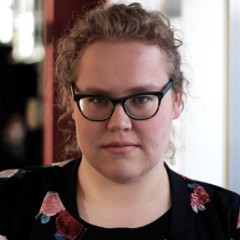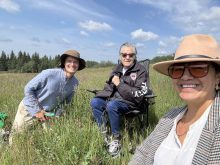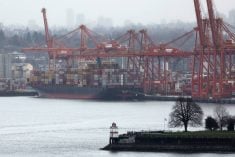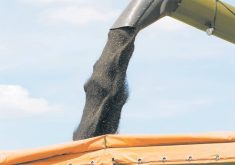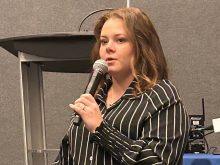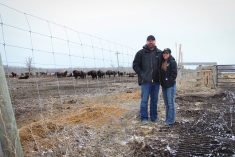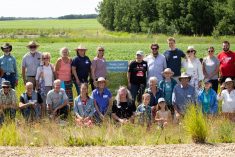First Nations farmers have often been frozen out of agricultural lending. An all-Indigenous team at Farm Credit Canada is working to ensure they get the capital they need.
“We’re taking Indigenous voices, we’re taking what you’re telling us, and we’re trying to implement that change here … to meet the needs of those that are on reserve,” said Monica James, senior director of Indigenous financing at FCC.
Why it matters: Indigenous communities, farmers and entrepreneurs have argued for more room for Indigenous opportunity in agriculture and food production, but opportunity often requires capital to get off the ground.
Read Also

Moo translator and methane measures: There’s an app for that
Dalhousie University researchers use artificial intelligence to create new dairy farm apps that analyze cattle sounds and measure methane.
The team launched in 2022, James said. Since April of that year, 845 customers self-reported as Indigenous, according to FCC’s 2023-24 annual report.
Indigenous is an umbrella term that could include First Nations peoples on or off reserve, Métis and Inuit. FCC clients can complete a self-declaration to say they are Indigenous. Métis and Inuit people do not fall under the federal Indian Act.
First Nations farmers have struggled to access borrowing due to constraints within the Indian Act. For example, they don’t own the land they occupy on reserves. The federal government does.
“They have the right of use and benefit of the land,” James said.
Inability to use land as collateral has often been cited as a barrier to borrowing.
In 2022, LouAnn Solway, a rancher on Siksika First Nation in Alberta, told CBC Radio that when she needed a loan as a young rancher to expand her cattle herd, she approached several banks seeking $150,00 to $200,000. The banks turned her down.
Because Solway did not own the land she ranched, she could not use it as collateral. Nor would the banks allow her to use her existing cattle herd as collateral because the Indian Act prohibits banks from entering the reserve to seize cattle if there is default on the loan.
Derrick Gould, who farms on Pinaymootang First Nation in Manitoba, told the Manitoba Co-operator in 2022 that even after he had established his farm, the bank would not loan him more than $20,000 at a time for similar reasons.
People living on reserves don’t file taxes, so they’re also unable to provide a notice of assessment to prove income, James added.
Making space
FCC’s Indigenous finance team is working to find ways around these legal conundrums, James said.
The lender has expanded the range of acceptable methods for borrowers to prove their income. It has raised the limit on unsecured loans (those that don’t require collateral) and is seeking other ways for First Nations farmers and food producers to get financing.
There are ways that land can be used as collateral, possibly by creating a mortgage of lease. Some nations use a certificate of possession system, which grants a lease to individual members of the community. In that case, that could also be used for a mortgage of lease.
James said First Nations farmers get à la carte lending from FCC instead of fitting them into existing programs. Though this takes the team more time, she said they do not charge Indigenous borrowers extra for that service.
Bias among lenders and lack of understanding about Indigenous borrowers’ needs has also been a barrier, James said.
Her team considers where Indigenous farmers, harvesters and processors are in their business journey and work to ensure FCC’s processes are in line. To do that, it has changed the requirements about what constitutes an eligible agri-food business.
There are four ways of Indigenous harvesting, James said: hunting, fishing, trapping and gathering. Fishing (farmed and freshwater wild fish) and gathering are both eligible categories at FCC. If an Indigenous producer gathers non-timber products from the forest (such as one client who gathers wild herbs for tea), or gathers wild rice, they can be eligible for financing.
This category isn’t available to non-Indigenous clients.
Along with access to capital, farm knowledge and connections to other Indigenous producers or to experts have also been barriers for Indigenous farmers. FCC staff have connected customers with experts who can help them build their farm or business.
In action
Rancher Terry Lerat said FCC has been one of 4C Farms’ greatest supporters.
Lerat, a band councilor with Cowessess First Nation in Saskatchewan, helped establish the farm for the First Nation in 2010. He grew up farming, owns his own cattle herd and has been dealing with FCC for years.
“It took them a little bit to get involved with us, but once they grasped what we’re trying to do, the amount of assistance we get from them … the willingness for them to help us, it’s unmatched.
“They want to see a First Nation farm do really well, whether it’s an individual farm or a corporate farm like what we’re trying to build.”
Cowessess bought the yard site and land, which eventually became 4C Farms, after a Treaty Land Entitlement claim was settled in 1996.
“We had no equipment at all, so along with building the farm, acquiring the land, we also had to put together a line of machinery,” Lerat said.
This year, 4C Farms seeded 6,000 acres and now has 200 cattle. Lerat said they are about “90 per cent there” with acquiring needed machinery. They’ve also made substantial improvements in herd genetics, with resulting higher prices for calves.
Lerat added that years ago, the band had to convince local suppliers that it would pay its bills. These days it has proven it is a viable farm and businesses are happy to give them credit.
Seeking
FCC haBs a lot of work to do just to find Indigenous farmers and let them know what’s available, James said.
“Trying to find a First Nations farmer on a reserve is literally like trying to find a needle in a haystack.”
To reach the general farming population, a company might go to a farm show, but few farm events are geared to Indigenous producers. James could think of only one such agriculture event in Canada, the Indigenous Agriculture Summit held during Canadian Western Agribition in Regina.
“We’re trying to make a difference in a space where they’ve never had support before,” James said. “We’re not about volume. We’re about impact.
“We’re trying to help everybody that we can. A $70,000 tractor is just as important as a $700,000 implement … $70,000 to a lending institution is really nothing, but to that one person, the impact and ripple effect that we can make with them means way more than lending out millions and millions of dollars.”

